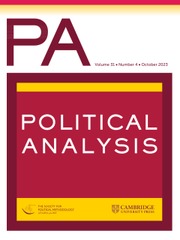Crossref Citations
This article has been cited by the following publications. This list is generated based on data provided by
Crossref.
Fariss, Christopher J.
2013.
Uncertain Events: A Dynamic Latent Variable Model of Human Rights Respect and Government Killing with Binary, Ordered, and Count Outcomes.
SSRN Electronic Journal,
2014.
Applied Bayesian Modelling.
p.
215.
Fogarty, Brian J.
and
Monogan, James E.
2014.
Modeling time-series count data: The unique challenges facing political communication studies.
Social Science Research,
Vol. 45,
Issue. ,
p.
73.
Sandler, Todd
2014.
The analytical study of terrorism.
Journal of Peace Research,
Vol. 51,
Issue. 2,
p.
257.
Ouyang, Yu
and
Waterman, Richard W.
2015.
How Legislative (In)Activity, Ideological Divergence, and Divided Government Impact Executive Unilateralism: A Test of Three Theories.
Congress & the Presidency,
Vol. 42,
Issue. 3,
p.
317.
RESODIHARDJO, SANDRA L.
CARROLL, BRENDAN J.
VAN EIJK, CAROLA J.A.
and
MARIS, SANNE
2016.
WHY TRADITIONAL RESPONSES TO BLAME GAMES FAIL: THE IMPORTANCE OF CONTEXT, RITUALS, AND SUB‐BLAME GAMES IN THE FACE OF RAVES GONE WRONG.
Public Administration,
Vol. 94,
Issue. 2,
p.
350.
Clayton, Govinda
and
Thomson, Andrew
2016.
Civilianizing Civil Conflict: Civilian Defense Militias and the Logic of Violence in Intrastate Conflict.
International Studies Quarterly,
Vol. 60,
Issue. 3,
p.
499.
Berrebi, Claude
and
Ostwald, Jordan
2016.
Terrorism and the Labor Force.
Journal of Conflict Resolution,
Vol. 60,
Issue. 1,
p.
32.
Perez, Iker
Brown, Michael
Pinchin, James
Martindale, Sarah
Sharples, Sarah
Shaw, Dominick
and
Blakey, John
2016.
Out of hours workload management: Bayesian inference for decision support in secondary care.
Artificial Intelligence in Medicine,
Vol. 73,
Issue. ,
p.
34.
Minhas, Shahryar
Hoff, Peter D
and
Ward, Michael D
2016.
A new approach to analyzing coevolving longitudinal networks in international relations.
Journal of Peace Research,
Vol. 53,
Issue. 3,
p.
491.
Ward, Michael D
and
Beger, Andreas
2017.
Lessons from near real-time forecasting of irregular leadership changes.
Journal of Peace Research,
Vol. 54,
Issue. 2,
p.
141.
Senninger, Roman
and
Bischof, Daniel
2018.
Working in unison: Political parties and policy issue transfer in the multilevel space.
European Union Politics,
Vol. 19,
Issue. 1,
p.
140.
Metulini, Rodolfo
Manisera, Marica
and
Zuccolotto, Paola
2018.
Modelling the dynamic pattern of surface area in basketball and its effects on team performance.
Journal of Quantitative Analysis in Sports,
Vol. 14,
Issue. 3,
p.
117.
Hsu, Henda Y.
Vásquez, Bob Edward
and
McDowall, David
2018.
A Time-Series Analysis of Terrorism: Intervention, Displacement, and Diffusion of Benefits.
Justice Quarterly,
Vol. 35,
Issue. 4,
p.
557.
Yang, Xiao
Ram, Nilam
Gest, Scott D.
Lydon-Staley, David M.
Conroy, David E.
Pincus, Aaron L.
Molenaar, Peter C. M.
and
Richardson, Michael
2018.
Socioemotional Dynamics of Emotion Regulation and Depressive Symptoms: A Person‐Specific Network Approach.
Complexity,
Vol. 2018,
Issue. 1,
Fukumoto, Kentaro
Beger, Andreas
and
Moore, Will H.
2019.
Bayesian modeling for overdispersed event-count time series.
Behaviormetrika,
Vol. 46,
Issue. 2,
p.
435.
Gaibulloev, Khusrav
and
Sandler, Todd
2019.
What We Have Learned about Terrorism since 9/11.
Journal of Economic Literature,
Vol. 57,
Issue. 2,
p.
275.
Yu, Xinhua
2020.
Risk Interactions of Coronavirus Infection across Age Groups after the Peak of COVID-19 Epidemic.
International Journal of Environmental Research and Public Health,
Vol. 17,
Issue. 14,
p.
5246.
Hsu, Henda Y.
and
McDowall, David
2020.
Examining the state repression‐terrorism nexus: Dynamic relationships among repressive counterterrorism actions, terrorist targets, and deadly terrorist violence in Israel.
Criminology & Public Policy,
Vol. 19,
Issue. 2,
p.
483.
Duck-Mayr, JBrandon
Hansford, Thomas G.
and
Spriggs, James F.
2021.
Agenda Setting and Attention to Precedent in the US Federal Courts.
Journal of Law and Courts,
Vol. 9,
Issue. 2,
p.
233.


